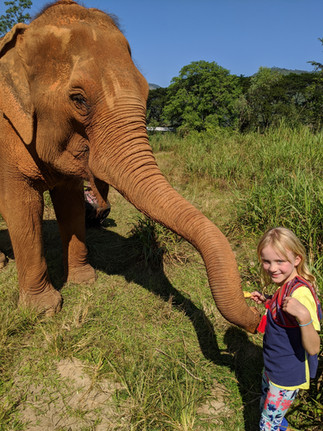A Day in the Life of an Elephant
- Sarah
- Dec 9, 2019
- 7 min read
Updated: Dec 12, 2019
Central/Northern Thailand is known for a large proportion of Thailand’s elephant population. Companies that offer the opportunity to see/ride/bathe/etc. elephants are a dime a dozen. Through a reco from www.travelfish.org we opted to go with Elephant Nature Park. They had a surprising number of tours to chose from, day and overnight. It was difficult to discern any material differences between the various day trips, but I ultimately landed on the Save Thai Elephant Park. Largely because it seemed like a smaller group experience and further afar from the main Elephant Park facilities.
Bit of Context
We went into our day knowing virtually nothing of the life or treatment of elephants in Thailand. Over the course of the day we learned about the largely inhuman treatment of elephants in captivity and the important work Elephant Nature Park does to help rescue & rehabilitate elephants to their natural life.
Total ~3,000-4,000 elephants in Thailand, of which about half are in the wild vs captivity/domesticated
Those in captivity are used largely for heavy labor of logging or tourist rides atop their backs. Both of these are physically very demanding for the elephants.
Naturally, in the wild, elephants eat 16 hours/day. Goes to show the contrasted life they have in captivity, getting nowhere near the amount of food/nutrition and free time that they’re naturally meant to have.
Elephant Nature Park buys elephants out of captivity. The going rate for an elephant is ~$50,000 USD. It’s a balancing act because they want to keep the buy price relatively low becuase otherwise they’ll create a market for just the thing they’re trying to limit.
ENP then works to rehabilitate the elephants to a life back in the wild. Virtually all of the elephants they take in have physical and/or mental trauma from their time in captivity.
Elephants are matched to a caretaker (mahout), someone who is responsible for their care & has a tight relationship with the elephant. The mahouts at ENP even live in the park, adjacent to their elephant. We saw firsthand how incredible the bond is between them; they spend almost every waking moment together.
ENP does not allow tourists to ride any of the elephants, and they generally take an approach of taking the lead from the elephants. For example, they do not force the elephants to bathe (this time of year the elephants don’t want to go in the water because it’s too cold) or do other things for the sake of tourists' entertainment.
Ready to Meet the Elephants
About an hour’s drive out of Chiang Mai, we arrived to some small huts outside of ENP’s main sanctuary. Our guide Bancha explained that we’d be hanging out with three female elephants that live on the particular plot of land we were on. The three elephants were in captivity together & bought out of it at the same time. The fact that they already knew each other and were “best friends” (per Bancha) meant that they could be placed together on their own in these 20 acres. The elephants were ages 27, 40 and 65 years old, and each had their own dedicated mahout caretaker. All three of them had markings where their saddles had been from tourists previously riding them. We put on traditional shirts and were ready to start the day. Here's a video of when the three elephants first arrived!
Meal Time
Bancha explained that elephants eat constantly, about 16 hours per day. That’s nuts! Our first task was to help prepare the morning meal for these herbivores. With large knives we peeled and hacked open huge amounts of pumpkins and watermelons. There were also mounds of small bananas and cucumbers, but those didn’t require any chopping or peeling.

Videos of everyone in action with food prep!
We finished cutting up all the produce and were just standing around. We asked Bancha if we were going to go get the elephants; he was like, “No, they’ll come. They know when it’s time to eat.” Sure enough, a few minutes later we heard the elephants before we saw them. Snapping of branches and a few elephant noises and they crept up the hill behind us, caretakers alongside them. Incidentally, the caretakers use only their voices and bags of bananas to keep the elephants moving; none of the sharp hooked sticks that are used in captivity to poke & prod the elephant to obedience. And when the elephants veered off to get more bamboo leaves, the caretakers just waited patiently & let the elephants do their thing. Here's a video of the three first arriving!
With the three elephants lined up, we were given the go-ahead to start feeding them. We were told to stand in front of the elephants, off a bit to the side; the elephants would take the food from us. Sure enough, they would snag the food from our hands, nestling it in their curled up trunk. Then they’d bring their trunk to their mouth & pop the food in. The first few times the girls were skittish, dropping their food instead of delivering it to the elephant :) But they/we eventually got the hang of it and found pleasure in being so up close to these animals. They were incredibly gentle & playful when they snatched up the food. The youngest elephant was a noisy eater and would scarf down her food at an impressive pace! The oldest elephant had lost all her teeth so she could only eat the soft foods like watermelon & bananas; no crunchy pumpkin for her. Check out everyone in action!
Let’s Stroll
Bellies full (or so we thought) the elephants moseyed on out, back into the beautiful jungle terrain around us. We cleaned up and then caught up to the elephants. They were leisurely walking along, stopping frequently to eat more (largely bamboo) leaves. We were literally feet from them the whole time, in awe of these huge creatures doing their thing.

At one point we branched off to walk towards the main ENP sanctuary. This main part of the organization is home to 80 elephants. We could see a bunch more elephants eating & playing along the shore of a river. We moved at a slow pace to take it all in, which was nice.
Time to Eat (Again)
We returned to our start point and it was time to eat . . . not the elephants, us this time :) They had a pretty yummy spread of vegetarian food. We were all quite hungry at that point so we dug in. Our bellies full, it was time to feed the elephants’ bellies again! This time we prepared rice balls for them. We squished together a number of ingredients (including rice, banana, tamarind and corn) and rolled them up into big balls. We hacked up some more pumpkin & watermelon, and were ready to go.
Like clockwork, the three ladies returned and we got back to feeding them. It was like old hat this time around :) The sheer volume of food these three elephants ate was impressive!! And that was just one small meal for the day! It was a real treat to be so intimately close to them for such extended periods of time. As we fed them, we’d get to pet their trunks. So cool!
Mud Bath?
At the beginning of the day Bancha told us it was unlikely we’d get to see the elephants bathe today. He explained that it’s not hot enough, and the water is too cold for the elephants; it’s much more likely in the March-July months to see them bathe. He also explained that ENP does not force the elephants to bathe because that goes against their aim to restore the elephants to their most natural, humane state of being. It’d be like making you take a bath in icy water just because some people came to visit you; it’s just not the right thing to do. When Bancha initially told us this, I was admittedly disappointed. But as the day went on, and we learned more about these elephants and the ENP program, we came to respect their decision not to force the elephants into any behavior, just for the sake of tourists.
To that end, after the rice ball ++ feeding, the elephants walked towards a little mud bath. They splashed mud and/or dirt onto their backs a few times (water & mud helps reduce their body temperature, as their skin has no pores; dust/mud helps act as a sunscreen & protection from insects) but largely were not interested. Goes back to the fact that it wasn’t hot enough outside to prompt them to needing/wanting to douse themselves in mud. Their mud coloring was a result of them opting to take a mud bath just the night before. Even though they weren’t terribly active in the mud, we weren’t fussed. And in fact, it was kind of appropriate; our day was all about observing a day in the life of an elephant, without any prompting, prodding or forcing. The day was all the more special for this. This video clip shows one of the elephants tossing dirt onto her back:
Final Facts
A few other fun facts we learned about elephants:
They splat (spread out) their ears to make them seem larger and intimidate other elephants
They receive low sound vibrations through their sensations in their feet & trunk
Musth is when males exhibit aggressive behavior; they have to be separated from females
Females live together in a herd/family and males become more solitary with age
They have the largest brain of any animal in the world and their brain is akin in complexity to that of humans
They sleep only about 4 hours per day
Zoos Will Never Be the Same
After our day shadowing the elephants, seeing them in a zoo will never be as pleasurable or feel right. We learned that elephants who experience mental or physical trauma often exhibit physical ticks of sorts (i.e. swaying back & forth is from logging industry). Come to think of it, we've noticed some of that in elephants we've seen previously in zoos. As with the case with any animal you get the opportunity to lean more about in their natural habitat, it will be tough to see them captive in zoos ahead.
An Experience to Remember
All in, it was an excellent day. The girls were skittish at first trying to feed the elephants, but gradually found comfort and contentment in it. We all recognized what a treat it was to experience a day-in-the-life of an elephant in such an organic way. We’re grateful we matched with Elephant Nature Park to experience the elephants in a humane way, and admire the work they’re doing to help rescue & rehabilitate elephants.
In Thailand, elephants signify happiness, health and luck. The three elephants we met today lucked out to be removed from harsh, captive conditions, and are now enjoying a phase of life where they can be truly healthy & happy, in the wild. Cheers to that!



















































Comments